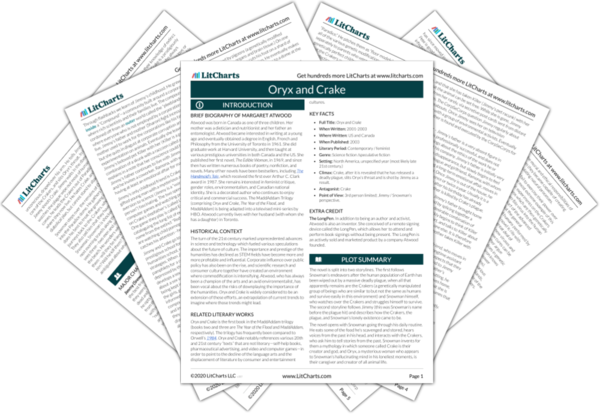The advanced science achieved in the world of the novel has challenged the distinction between human and animal. Pigoons, for example, are pigs that grow human organs and even human brain tissue (for the purpose of transplantation). Their partially human makeup makes it so that people are uncomfortable with the idea of eating them, because it seems vaguely cannibalistic. They are the book’s first, but certainly not only, example of transgressing the divide between human and animal. The most distinctive blend of human and animal are Crake’s genetically engineered creation, The Crakers. They have color-changing sex organs like a baboon, a digestive system like a rabbit, and the smell of a citrus plant. The Crakers are a particularly interesting example because they are humanoid, with certain human traits, and the book constantly asks the reader if they are human, and if they are, what makes them so.
The characters of the novel also often think about the distinction between animals and humans, though in very different ways. Jimmy frequently compares himself to various animals. In Jimmy’s case this kind of comparison grows out of his feeling inferior given that he is not scientifically gifted. His lack of scientific genius makes him feel lesser, like an animal. Crake, conversely, thinks that human ingenuity and scientific curiosity is actually an inferior, animal trait. He refers to the scientific human brain as a “monkey brain,” and disdains scientific genius (though he himself possesses a great deal of it.) He also believes those things which are traditionally revered as “distinctly human” (love, art, language, self awareness, knowledge of mortality) are a kind of evolutionary mistake—he finds them to be “inelegant” solutions to the problem of life and survival. His solution to these problems, on the one hand, is the “invention” of the Crakers, whom he considers to be “superior” genetic combinations of humans, plants, and animals that share neither human intelligence or sexual desire. On the other hand, he solves what he sees as the problem of human beings by developing a plague that effectively wipes them off the face of the earth.
Oryx and Crake therefore wonders about the difference between human and non-human life—is it a matter of intelligence? Of self-awareness? Of artistic creativity, religion, or philosophy? All of these answers are presented as possibilities, but Atwood does not indicate that any one answer is the “correct” one. The question itself is indicative of Atwood’s environmentalism. While the characters in the novel seem fixated on the distinction between humans and animals, the novel challenges this distinction in the first place and suggests instead that humans do not exist somehow separately from or outside of nature, that humans are not obviously distinct from the other kinds of life in their environment and were mistaken to ever treat themselves as being so.
Humans & Animals ThemeTracker

Humans & Animals Quotes in Oryx and Crake
He thought of pigoons as creatures much like himself. Neither he nor they had a lot of say in what was going on.
There’d been a lot of fooling around in those days: create-an-animal was so much fun, said the guys doing it. It made you feel like God.
But love was undependable, it came and then it went, so it was good to have a money value, because then at least those who wanted to make a profit from you would make sure you were fed enough and not damaged too much.
Crake thought he’d done away with all that…God is a cluster of neurons, he’d maintained…They’re up to something though. Something Crake didn’t anticipate. They’re conversing with the invisible. They’ve developed reverence.
Sex is no longer a mysterious rite, viewed with ambivalence or downright loathing, conducted in the dark and inspiring suicides or murders. Now it’s more like an athletic demonstration, a free-spirited romp.
Maybe the guards tried to get out of RejoovenEsense just like everyone else. Maybe they, too, hoped they could outrun contagion.
“If you take ‘mortality’ as being, not death, but the foreknowledge of it and the fear of it, then ‘immortality’ is the absence of such fear. Babies are immortal. Edit out the fear and you’ll be…”
“Sounds like Applied Rhetoric 101.”
Here are Crake and Oryx, what’s left of them. They’ve been vulturized, they’re scattered here and there, small and large bones mingled into disarray…He’s grinning with all the teeth in his head. As for Oryx, she’s face down, she’s turned her head away from him as if in mourning. The ribbon in her hair is as pink as ever.
Our arboreal ancestors, Crake used to say. Used to shit on their enemies from above while perched in trees. All planes and rockets are simply elaborations on that primate instinct.
“We made a picture of you, to help us send out our voices to you.”
Watch out for art, Crake used to say. As soon as they start doing art, we’re in trouble.











